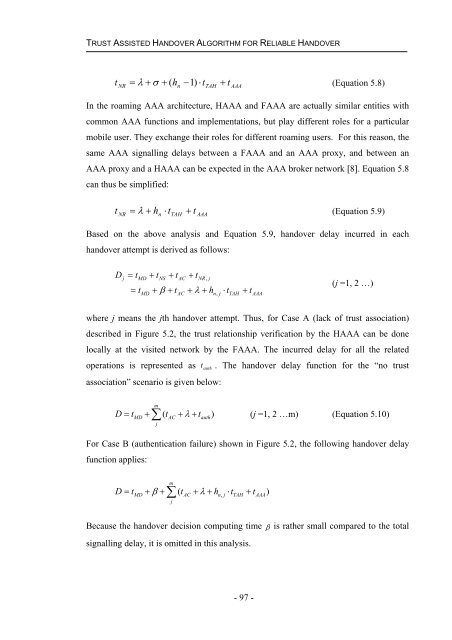Handover mechanisms in next generation heterogeneous wireless ...
Handover mechanisms in next generation heterogeneous wireless ...
Handover mechanisms in next generation heterogeneous wireless ...
You also want an ePaper? Increase the reach of your titles
YUMPU automatically turns print PDFs into web optimized ePapers that Google loves.
TRUST ASSISTED HANDOVER ALGORITHM FOR RELIABLE HANDOVER<br />
t � � � � � ( h �1)<br />
�t<br />
� t<br />
(Equation 5.8)<br />
NR<br />
n<br />
TAH<br />
AAA<br />
In the roam<strong>in</strong>g AAA architecture, HAAA and FAAA are actually similar entities with<br />
common AAA functions and implementations, but play different roles for a particular<br />
mobile user. They exchange their roles for different roam<strong>in</strong>g users. For this reason, the<br />
same AAA signall<strong>in</strong>g delays between a FAAA and an AAA proxy, and between an<br />
AAA proxy and a HAAA can be expected <strong>in</strong> the AAA broker network [8]. Equation 5.8<br />
can thus be simplified:<br />
t � � � h �t<br />
� t<br />
(Equation 5.9)<br />
NR<br />
n<br />
TAH<br />
AAA<br />
Based on the above analysis and Equation 5.9, handover delay <strong>in</strong>curred <strong>in</strong> each<br />
handover attempt is derived as follows:<br />
D<br />
j<br />
� t<br />
� t<br />
MD<br />
MD<br />
� t<br />
NS<br />
� t<br />
� � � t<br />
AC<br />
AC<br />
� t<br />
NR,<br />
j<br />
� � � h<br />
n,<br />
j<br />
� t<br />
TAH<br />
� t<br />
- 97 -<br />
AAA<br />
(j =1, 2 …)<br />
where j means the jth handover attempt. Thus, for Case A (lack of trust association)<br />
described <strong>in</strong> Figure 5.2, the trust relationship verification by the HAAA can be done<br />
locally at the visited network by the FAAA. The <strong>in</strong>curred delay for all the related<br />
operations is represented as t auth . The handover delay function for the “no trust<br />
association” scenario is given below:<br />
m<br />
D � tMD<br />
��<br />
( tAC<br />
� � � tauth)<br />
(j =1, 2 …m) (Equation 5.10)<br />
j<br />
For Case B (authentication failure) shown <strong>in</strong> Figure 5.2, the follow<strong>in</strong>g handover delay<br />
function applies:<br />
m<br />
D � tMD<br />
� � ��<br />
( tAC<br />
� � � hn,<br />
j �tTAH<br />
� tAAA)<br />
j<br />
Because the handover decision comput<strong>in</strong>g time � is rather small compared to the total<br />
signall<strong>in</strong>g delay, it is omitted <strong>in</strong> this analysis.












